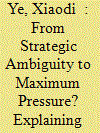| Srl | Item |
| 1 |
ID:
188942


|
|
|
|
|
| Summary/Abstract |
How do changes in US Taiwan policy play out? What is the logic behind these changes? To address these questions, existing studies have formulated four schools of explanation, providing valuable theoretical insights. However, these studies have obvious problems with unidirectional dichotomy and thus fail to identify a causal mechanism explaining the long-term trajectory of US Taiwan policy. This article conducts a re-typology of US Taiwan policy to break the traditional strategic ambiguity–clarity dichotomy by establishing three key indicators and argues that the orientation of US China policy and Taiwan’s US policy are the two major factors triggering changes. By conceptualizing and operationalizing the two independent variables as engagement-oriented, coopetition-oriented, containment-oriented, and hedging/bandwagoning/binding, this article develops a systemic theoretical framework to demonstrate how the US Taiwan policy transits between strategic clarity, maximum pressure, partial strategic clarity, between partial strategic clarity and strategic ambiguity, strategic ambiguity, and controlling the pro-independent forces. This article conducts empirical studies by reviewing the transition of US Taiwan policy under different presidencies in post–Cold War era to demonstrate how the theoretical framework works in realpolitik.
|
|
|
|
|
|
|
|
|
|
|
|
|
|
|
|
| 2 |
ID:
095556


|
|
|
|
|
| Publication |
2010.
|
| Summary/Abstract |
The US strategic ambiguity versus clarity has been a centerpiece in maintaining cross-strait stability since the 1995-96 Taiwan Strait crisis. Dialogues and debates abound regarding the relative effectiveness of discrete US policy choices. The current thaw in cross-strait relations does not forestall decisively the resurgence in the long run of the cross-strait tensions during 2000-08, rendering the strategic ambiguity/clarity still a relevant issue. This article argues that the discussions on the issue are seriously plagued by the lack of a sufficiently rigorous and commonly shared conceptualization of strategic ambiguity/clarity, and an internal logical contradiction or an inadequate practical utility as a tool to aid policy-making. To address these problems, this article seeks to clarify and elaborate on the conceptual foundation of strategic ambiguity/clarity by differentiating between two distinct analytic levels thereof, and proposing a conceptual framework for a fuller understanding of the US policy along various dimensions. It also reappraises some major issues or problems found in the existing discussions and US practice, and suggests possible solutions.
|
|
|
|
|
|
|
|
|
|
|
|
|
|
|
|